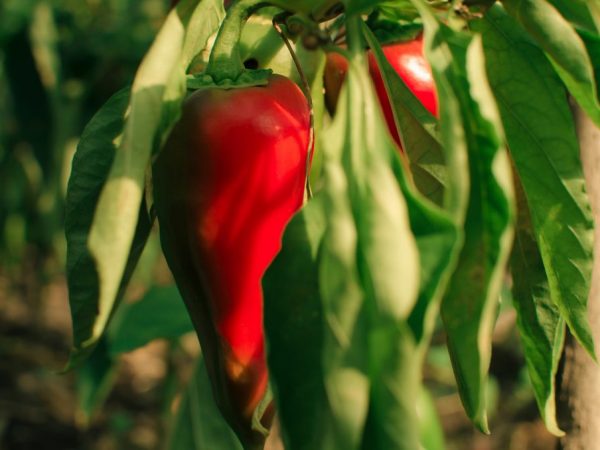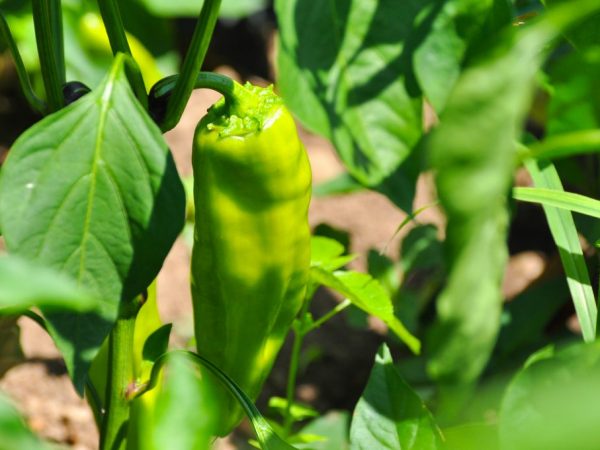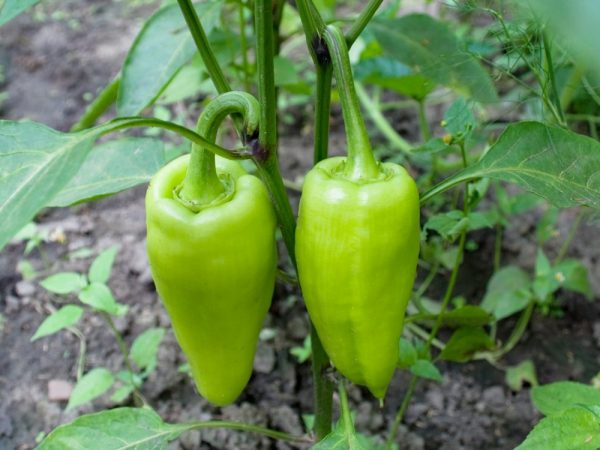Characteristics of the Kupets pepper variety
Pepper Kupets is an early variety of sweet bell peppers. The variety was bred for cold areas with short summers. Therefore, the variety is cold-resistant. We will consider a detailed description of the variety in the article.

Characteristics of the Kupets pepper variety
Variety characteristic
The Merchant pepper variety is unpretentious in care. When growing, you need to monitor the moisture content of the soil and ensure that the room is well lit. Suitable for growing in the open field and in the greenhouse.
Even in unfavorable conditions, the plant gives a yield of 2-3 kg per 1 sq.m. In good conditions, the yield reaches 7-10 kg per 1 sq. M.
Fruit weight - up to 100 g, stack thickness - 5-8 mm. The fruits are very tasty: the pulp is juicy and aromatic, it contains many vitamins. The color is green at the stage of technical ripeness and red at the stage of biological maturity. The fruits are stored for a long time and tolerate transportation well.
They are consumed both raw and processed. Raw fruits can be used for salads or as a garnish. They can be stewed, baked, added to soups and borscht.
Description of the bush
Semi-spreading, pyramidal bush. Has the following characteristics:
- The height of the bush reaches 80 cm and has a thick stem.
- The growing period is 60-65 days as seedlings, 50-55 days outdoors or in a heated greenhouse.
- The optimum temperature for growing is 26-28 ° C, at night - 15-18 ° C. It is one of the few species that can withstand temperatures up to 10 ° C at night. With a decrease in temperature, growth slows down.
Care
Seeds are sown at home or in a heated greenhouse at a temperature of 26-28 ° C during the day and 15-18 ° C at night. The time from planting to harvest is approximately 110 days. Therefore, it is undesirable to sow directly into the ground - the fruits will not have time to ripen by the end of warm days. Seeds are usually planted in late February or early March.
The seeds germinate well at home. But before landing, they need to be checked and selected:
- Preliminary selection. Empty seeds are discarded, dense and full seeds are left.
- Test landing. From the total volume of seeds, several are selected and placed in wet gauze for 7 days. If the seeds have hatched, they can be used further.
- Place the seeds in a saline solution. Add 40 g of table salt to boiled water (1 l) and stir. The seeds are placed in the solution. Those that surfaced are empty, they are thrown away. The drowned can be planted.
Seeds are planted in containers with soil to a depth of 1 cm.After the appearance of 5-6 leaves, the seedlings are pinched. Cut off the top of the stem to form side branches. Subsequently, all leaves up to the first fork are also removed.

Plants need to be looked after
The soil of the Kupets pepper variety loves loose and fertile. Ground is perfect after cabbage, carrots, onions or herbs.
The plant can begin to bloom immediately after transplanting it outdoors. These flowers must be cut to allow the plant to take root well.
Picking
When diving, the Merchant may slow down in growth and there is a possibility of damage to the roots.
If a pick is still necessary, replant from moist soil so as not to damage the root system. The picking period is after the appearance of the first 1-2 true leaves.
Hardening
Seeds and seedlings can be hardened so that they can tolerate low temperatures well. They act on the following principles:
- The seeds are accustomed to the cold by placing them in the refrigerator for several hours. Seed hardening must be carried out before hatching.
- Some gardeners put the seeds in the refrigerator overnight.
- Seedlings for hardening are usually taken out for several hours outside or on a balcony. Hardening should be started 2 weeks before planting in the ground.
By the end of May, the seedlings are planted in the ground. Planting pattern: 45 cm - between bushes, 45 cm - between rows.
Watering
Bell pepper The merchant loves moist soil, but dry air. Do not overfill or overdry. This will immediately affect the condition of the plant.
Pepper bushes prefer warm water. It can be settled in separate containers.
Basic principles of watering:
- seedlings before the first shoots should be watered every 2-3 days;
- seedlings after sprouting are watered daily in the morning;
- before the picking procedure, the soil is watered for 2 hours.
After transplanting into open ground, it is necessary to water every day. Peppers can be watered in the evening. Only this should be done after sunset.
Top dressing

Plants need phosphorus during fruiting.
Fertilizers are applied together with water. Usually, fertilizing begins immediately with planting.
Basic feeding rules:
- To fertilize seedlings, use a solution of nitrophoska at the rate of 1 tbsp. l per 10 l of water. You can use cow dung instead of nitrophoska. You can also take a solution of bird droppings. To do this, dry manure is settled in water in a ratio of 1 to 20 for several hours. During the growth of seedlings, plants are fertilized 2 times with a gap of 10 days.
- Potash fertilizers can also be used for seedling growth. In the first feeding, 0.5 tsp. urea and 2.5 ml of sodium humate are dissolved in 1 liter of water. In the second, 1 tsp is added instead of sodium humate. potassium monophosphate.
- 1 week after picking, the seedlings can be watered with Plants or Kemira solution.
- The first time after transplanting into open ground, the peppers are fertilized only after 2 weeks. Use a solution of ammonium nitrate 1 tbsp. on a bucket of water, potassium sulfate 1-1.5 tbsp. per bucket, superphosphate 2 tbsp. 10 liters of water.
- During flowering, fertilize with an organic solution - 1 kg of manure (0.5 kg of bird droppings) is soaked in a bucket of water for a week. Add 2 tablespoons to the solution. potassium monophosphate.
- During fruiting, wood ash is introduced at the rate of 2 cups per 1 sq.m.
Phosphate dressing is applied before flowering. Needed for the growth of stem and leaves.
Nitrogen fertilizers are applied before flowering, sometimes during fruiting. Phosphate fertilizers - during fruiting.
For the best effect, fertilization can be alternated. Combine mineral and organic.
Pests and diseases
Pepper Merchant is susceptible to disease. They are especially manifested with improper care, lack or excess of nutrients in the soil, improper seed treatment.
Description of the main diseases and methods of combating them:
- Blackleg. Appears on overflow or low temperature. The main method of struggle is sheltering from the cold with agrofibre or film, drying and loosening the soil. When overflowing, the soil is covered with wood ash.
- Rot is gray. The fruits are stained. It manifests itself during rains or overflow. It needs to be sprayed with fungicides. Damaged fruits, leaves and stems must be removed from the plant.
- Spotted wilting. The leaves turn bronze or purple. The fruits acquire yellow and brown rings. It is necessary to spray with fungicides. The best is Fundazol. The fruits should be collected, and watering should be stopped.
When any disease appears, it is necessary to separate the diseased plant from others. If this is not possible, then pluck the damaged leaves, fruits and stems. It is best to burn the affected parts of the bushes.
Pests
Timely pest control measures will protect the entire crop. Pepper Merchant tastes sweet, so many insects love it. The main ones are:
- Spider mite. It can be found on the underside of the sheet. A garlic or onion solution is usually used against it. In a meat grinder, you need to grind a glass of onion or garlic and soak it in 10 liters of water. Add 1 tbsp. liquid soap. Strain the solution and spray on diseased plants. It can also be sprayed for prophylaxis.
- Aphid. The most dangerous insect for plants. Against it, you can spray 1 tbsp with a solution of karbofos. 10 liters. Cannot be used during flowering. You can use folk methods. Spray with a solution of wood ash at the rate of 1 cup per 10 liters.
- Naked slugs. Not visible during the day. They can only be found in the rain or in the evening. Crawling out of the weeds. The way to fight is to sprinkle the soil with quicklime 3 times a day. This should be done day after day.
Spraying against insects is often carried out as a prophylaxis. Preventive measures are taken 2 weeks before the seedlings enter the open ground.
Conclusion
Pepper Kupets is frost-resistant, resistant to disease, drought and waterlogging. Produces delicious fruits that are perfect for fresh consumption. It is appreciated for its high yield - 7-8 kg from 3-4 bushes.


